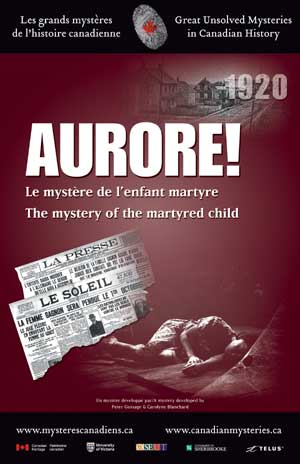 Great Unsolved Mysteries in Canadian History
Great Unsolved Mysteries in Canadian HistoryCanadian history is not boring -- but how it is presented usually is. Our history brims over with great stories of bravery, cruelty, passion and mystery. This series aims to bring the vast scope of our history to Canadians by telling twelve of these compelling stories. Everyone loves to solve a mystery and these are great mysteries. Each of the website archives is a story about a riveting moment in Canadian history, when in a flash of violence or discovery, underlying tensions between cultural groups, religious ideologies, individuals and governments, or just between people, are momentarily made visible. Few of these events occupy centre stage in Canadian historical texts. But they are “great mysteries” because of the access they give us to the themes of discovery, cross-cultural conflict, slavery, sex, frontier justice, religious factionalism, and to the barely mediated lives of Canadians in years and centuries past. Each of the mysteries in the series has been carefully selected so that the diversity of Canadian history is reflected in the landscapes, time periods, ethnic groups and themes highlighted.
The nine mysteries now available are:
1 Who Killed William Robinson? Race, Justice and Settling the Land

When three Black men are murdered in the space of 18 months around 1868 on bucolic Salt Spring Island, alarm bells go off. Who is killing the Blacks of Salt Spring? A year later an aboriginal man was charged, tried and hanged in short order for one of the murders, that of William Robinson. But did he really do it? Take a close look at the evidence. If it was not him, who did it?
2 We Do Not Know His Name: Klatsassin and the Chilcotin War
As dawn broke on April 30, 1864, some 25 Tsilhqot'in men surprised the sleeping camp of a crew building a road to the Cariboo gold mines. Of the 15 road-builders, only three escaped with their lives. Was it unprovoked or was it revenge? Was it an act of terrorism or war or the worst mass murder of Whites by Aboriginal People in British Columbia history? Who was the leader, and if this was war, who won?
3 Aurore! The Mystery of the Martyred Child

Fortierville, February 1920, looked like a quiet Quebec village -- fields blanketed with snow and wood stoves burning in the simple wooden houses grouped around a tall church spire. A peaceful scene -- you might think. But in one house on the edge of the village, a young girl, only ten years old, was being beaten, whipped and burned. Who could have done this? How, in such a small village where everyone knew everyone else's business, could such a thing not be noticed? Not until they were faced with a corpse. And why does this tragic case still haunt the collective memory of the Québécois?
4 Torture and Slavery: Angélique and the Burning of Montreal
When Montreal caught fire in April 1734, suspicion fell on Marie Angelique, a black slave accused of setting the fire to cover an escape with her white lover, a salt smuggler exiled from France. But if that was her motive, why did she stay to help her mistress save her possessions instead of fleeing. True she confessed but only after torture. Her punishment was to be hanged and then burnt. But did she really start the fire? What does her story tell us about slavery, torture and fire in early Canada?
5 Heaven and Hell on Earth: The Massacre of the "Black Donnellys"
The notorious Donnellys emigrated from Ireland in the 1840s with the hope of finding success in what would later become Canada. Yet, in 1880 the Donnelly farm was burned to the ground. The bodies of James, his beloved Johannah, their son Tom and niece Bridget were in the ashes, the victims of a vicious mob. Another son lay dead in a separate murder the same night. To this day, despite a great deal of evidence (including an eye witness), no one has been found guilty of the crime. Many had no doubt “who done it”, but two trials ended without any guilty verdict. Was this a community taking justice into their own hands when the justice system failed, or was it mob rule terrorizing rural Ontario? Did the Donnellys deserve their fate? Why was there no justice for the Donnellys?

6 Explosion on the Kettle Valley Line: The Death of Peter 'the Lordly' Verigin When an explosion destroyed the train car of the leader of the pacifist Doukhobor religious community, killing their aristocratic leader, his 17-year old female companion and seven other people including a member of the legislative assembly, near Castlegar B.C. in October 1924, there were many theories about who did it. Was it dissident Doukhobors upset with his worldly ways, nativist zealots jealous of the success of the Russian émigrés, agents of the Canadian or B.C. government trying to undermine Doukhobor pacifism and resistance to public schooling, Verigin's own son, Soviet enemies with a score to settle, or merely an accident? To this day the explosion that rocked the Doukhobor community, and threw light onto Canadians attitudes to immigrants in the inter-war era, remains an unsolved mystery.
7 Jerome: The mystery man of Baie Sainte Marie. One September morning in 1863, the tiny Acadian community of Meteghan, Nova Scotia, was shocked to hear that a legless man had washed up, alive, on the beach at nearby Sandy Cove. Taken in and cared for by the people of Meteghan for the rest of his life, the mystery man recovered his health -- but not his voice. He is said to have spoken only three words: ‘Jerome’, ‘Trieste’ and ‘Colombo’. Who was he, where did he come from, and how did he end up, mute and legless, on their beach were questions he never answered. The townspeople turned him into a tourist attraction but these questions kept the townspeople guessing well past his death in 1912, a half century later, and spawned a large body of folklore.

8 Where was Vinland? At the end of the first millennium a Viking ship led by Leif Eriksson arrived on the shores of North America, and wrote about their new home: Vinland, Land of Wine. Here grapes grew wild, the timber was magnificent, the salmon bigger and more plentiful than they had ever seen, and the climate so mild that cattle could graze out of doors all winter. They thought that they had found Eden and made it home - but their paradise was already inhabited. One morning Skrælings arrived in their bay and Europeans and indigenous Americans met for the first time in history. But where was this historic spot? Could it have been the desolate L’Anse au Meadows site in Newfoundland, the only Viking site identified in North America? Who were the Skrælings and why did this Viking colony die?
9 Who Discovered Klondike Gold? When George Carmack burst into a saloon in Circle City, Alaska, loudly proclaiming that he had struck gold further up the Yukon River, nobody believed him. Then he tipped a shotgun shell over and out poured the nuggets. It was August 1896, and he gets the credit for starting the Klondike Gold Rush, the greatest gold rush in the history of the world and a turning point in Canadian history.
But was it George or his Tagish, wife Shaaw Tlaa, or her brother brother Keish (Skookum Jim) and nephew Kaa Goox (Dawson or Tagish Charlie) and was George just the front-man because he was white and could stake a claim? Or should the credit go to Robert Henderson who had told Carmack where to pan for gold?
Funding application pending for launch April 2008
10 Love and Death in Montreal’s Square Mile: the Redpath Mystery

Was it the butler in the bedroom, or the Mistress in the powder room? When shots rang out at the Redpath mansion in Montreal’s most elite neighbourhood at 6 p.m. on June 13, 1901 and the servants found Ada Maria Mills Redpath dead and her 24-year old son dying, why didn’t they call the police? Why are two servants credited with the discovery of the victims in the newspaper, while the coroner’s report suggests that Peter Redpath, another son, found the bodies? Only two shots were heard and yet three bullets were retrieved from the bodies. In this case which might have served as the inspiration for the b 2 oard game Clue, we get a voyeuristic look into the lives of the rich and famous as we try and find out what really happened?
11 Death on a Painted Lake: Was Tom Thomson murdered and where did he go after he died? The death of Tom Thomson in the summer of 1917 has contributed to the mythic status of the painter as a rugged wilderness man, a sensitive genius whose life was cut short by cruel fate. For some, however, Thomson's death has also become the focal point of an unresolved and complex set of mysteries. Was the drowning of the excellent canoeist on a calm July day accidental, or did it have some connection to a love triangle and a German American draft dodger hiding in the remote resort? To many who knew Thomson, or who have come to love his art work so associated with the iconic “Group of Seven”, the circumstances of his death suggest no other conclusion but that he was murdered and that his body does not lie at its apparent final resting place.
12 Death of a Diplomat: the Case of Herbert Norman. What would persuade the Canadian ambassador to jump from a window of one of Cairo’s tallest buildings to certain death? In 1956, Cambridge educated, highly respected diplomat, Herbert Norman, was hand picked by Canadian Primer Minister Pearson to be his point man in Egypt during the Suez Crisis. Pearson later won the Nobel Peace Prize for his work. Norman, who had earlier served as a special assistant to the Supreme Commander Allied Powers in occupied Japan, General Douglas MacArthur, was under investigation by the infamous American Senator Joe McCarthy as a communist in the midst of cold war tensions. Was he a communist, a spy, or a loyal and effective diplomat? Why did he kill himself? His ambiguous suicide note only made the situation more mysterious.